Copies and views of Numpy array
When manipulating arrays, their data may or may not be copied into a new array. Let’s look at different cases.
1x = np.arange(12)23# Just a new name, no data is copied4y = x56print(x) # [ 0 1 2 3 4 5 6 7 8 9 10 11]7print(y) # [ 0 1 2 3 4 5 6 7 8 9 10 11]8print(x is y) # True, as they are same objects
When we index or slice a numpy array, the resulting array shares same data i.e. the result array is a view for the original array.
1x = np.arange(1, 13).reshape((3, 4))2print(x)34y = x[:, 1:3] # x and y share same data5print(y)67y[0, 0] = 123 # Changing the shared data8print(x)9print(y)
[[ 1 2 3 4] [ 5 6 7 8] [ 9 10 11 12]] [[ 2 3] [ 6 7] [10 11]] [[ 1 123 3 4] [ 5 6 7 8] [ 9 10 11 12]] [[123 3] [ 6 7] [ 10 11]]
copy() method of a numpy array can be used to create a new array which does not share data with the original array.
1x = np.arange(1, 13).reshape((3, 4))2print(x)34y = x[:, 1:3].copy()5print(y)67y[0, 0] = 123 # Changes the copy only8print(x)9print(y)
[[ 1 2 3 4] [ 5 6 7 8] [ 9 10 11 12]] [[ 2 3] [ 6 7] [10 11]] [[ 1 2 3 4] [ 5 6 7 8] [ 9 10 11 12]] [[123 3] [ 6 7] [ 10 11]]
np.array infers dtype based on types of numbers in the argument.
1import numpy as np23x = np.array([10, 20, 30])4print(x) #[10 20 30]5print(x.dtype) # int6467x = np.array([1.2, 3.14, 10.15])8print(x) #[ 1.2 3.14 10.15]9print(x.dtype) # float641011x = np.array([10.0, 20, 30])12print(x) #[10. 20. 30.]13print(x.dtype) # float64
1import numpy as np23# we can explicity specify what dtype we want:4x = np.array([10, 20, 30], dtype=float)5print(x) #[10. 20. 30.]6print(x.dtype) # float6478# float is truncated to int (not rounded)9x = np.array([1.2, 3.14, 10.65], dtype=int)10print(x) #[ 1 3 10]11print(x.dtype) # int64
Different shapes for different purposes
[1.0 5.0 3.5 4.0 5.0 1.2]
One point in 6D euclidean space
[[1.0 5.0 3.5]
[4.0 5.0 1.2]]
Two points in 3D euclidean space
[[1.0 5.0]
[3.5 4.0]
[5.0 1.2]]
Three points in 2D euclidean space
1import numpy as np23x = np.arange(1, 13) # 1D array4print(x)56# 2D array, a 3x4 matrix7matrix1 = x.reshape((3, 4))8print(matrix1)910# 2D array, a 2x6 matrix11matrix2 = matrix1.reshape((2, 6))12print(matrix2)1314 # 1D array15y = matrix2.reshape((12,))16print(y)
[ 1 2 3 4 5 6 7 8 9 10 11 12] [[ 1 2 3 4] [ 5 6 7 8] [ 9 10 11 12]] [[ 1 2 3 4 5 6] [ 7 8 9 10 11 12]] [ 1 2 3 4 5 6 7 8 9 10 11 12]
Special values — numpy.nan, numpy.inf
Numpy has special values to represent invalid or extreme values that result from numerical computation
- numpy.nan (not a number)
- numpy.inf (infinity)
1import numpy as np23arr = np.array([-1, 0, 1, 2, 3, 4])45print(np.log(arr))6#[ nan -inf 0. 0.69314718 1.09861229 1.38629436]
1# Any operation on np.nan results in np.nan2print(np.nan * 10, 0 / np.nan)3# nan nan45# Some operations are allowed on np.inf67print(np.inf, -np.inf)8# inf -inf910print(0 / np.inf, 1 / np.inf)11# 0.0 0.01213print(np.inf * np.inf, 100 + np.inf)14# inf inf
Slicing 2D array
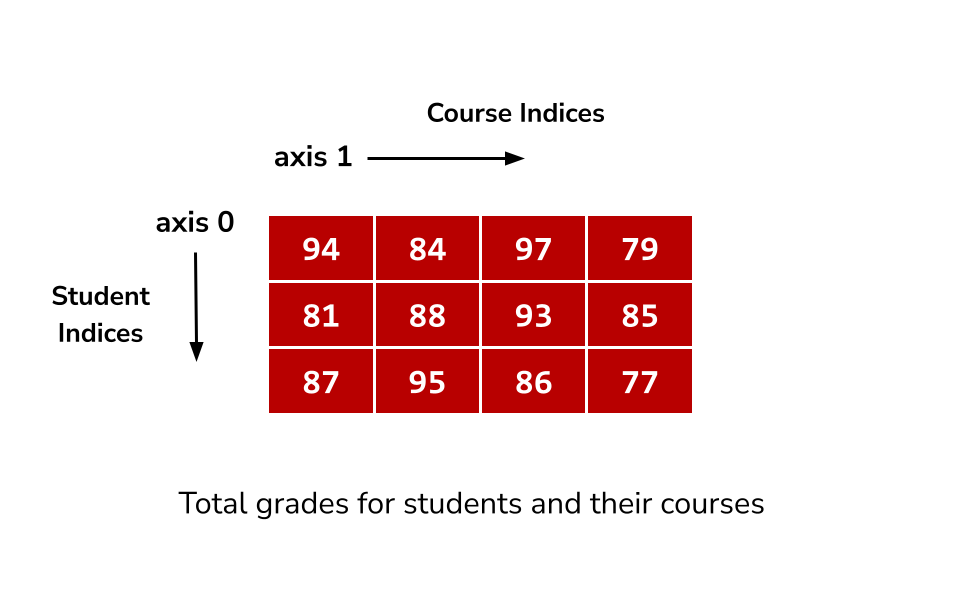
1import numpy as np23grades = np.array([[94, 84, 97, 79],4 [81, 88, 93, 85],5 [87, 95, 86, 77]])67print('Grades for student 1, course 2:')8print(grades[1, 2]) # 9391011print('All grades for student 2:')12print(grades[2, :]) # [87 95 86 77]1314print('All grades for course 0:')15print(grades[:, 0]) # [94 81 87]
Assigning values using indices and slices
1import numpy as np23grades = np.array([[94, 84, 97, 79],4 [81, 88, 93, 85],5 [87, 95, 86, 77]])67# Setting same value to all indices in the slice8grades[0:2, 1:3] = 1009print(grades)10# [[ 94 100 100 79]11# [ 81 100 100 85]12# [ 87 95 86 77]]
1import numpy as np23grades = np.array([[94, 84, 97, 79],4 [81, 88, 93, 85],5 [87, 95, 86, 77]])67# Setting values from array of same shape8grades[0:2, 1:3] = np.array([[10, 20], [30, 40]])9print(grades)10# [[94 10 20 79]11# [81 30 40 85]12# [87 95 86 77]]
Matplotlib
- Matplotlib is an extensive Python library commonly used to generate different types of plots.
- To install Matplotlib: if you use Thonny, go to Tools -> Manage packages. Type matplotlib on the search bar and click “Search on PyPI”. Then click Install.
- If you do not have Thonny, you can do so by typing the following commands in the terminal:
python -m pip install -U pip python -m pip install -U matplotlib
matplotlib.pyplot
- matplotlib.pyplot is a module in the package Matplotlib.
- This is the module we’ll be using to create plots.
- To use it, we first need to import it
import matplotlib.pyplot as plt - For more details: https://matplotlib.org/devdocs/api/pyplot_summary.html
Example – A Line plot
We can use the function plot to create a line plot between the points in the input sequence.
1import matplotlib.pyplot as plt23some_numbers = [3, 1, 5, 2, 9, 3]4plt.plot(some_numbers)5plt.show() # display figure
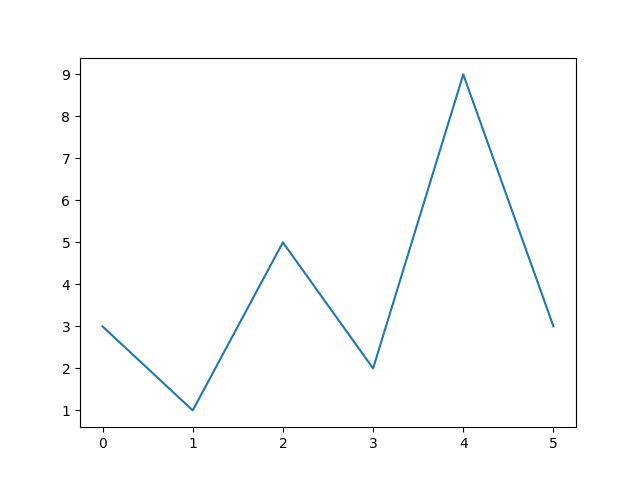
In the previous example:
- We provided only one input to the function plot.
- If we do that, then the input values are going to be considered as the y-coordinates. Their corresponding x-coordinates are the indices of the list.
- In the example, we plot the following points: (0,3),(1,1),(2,5),(3,2),(4,9),(5,3)
Example - two inputs
1import matplotlib.pyplot as plt23x_coord = range(0, 10, 2)4y_coord = [0, 0, 9, 8, 2]5plt.plot(x_coord, y_coord)6plt.show()
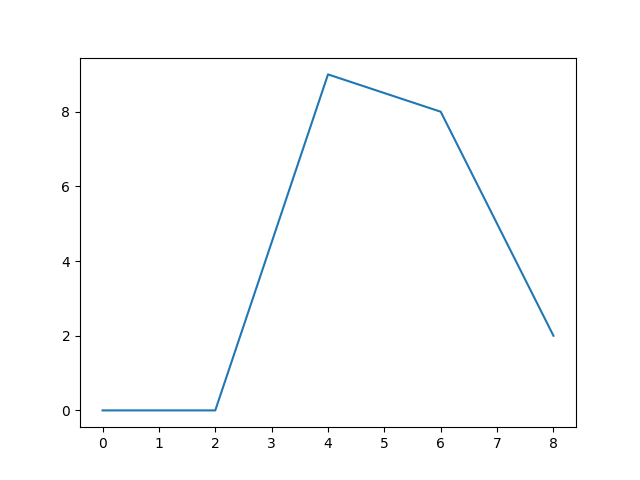
Example - a linear function
Using pyplot, we can plot the graph of the linear function y=x+5.
1import matplotlib.pyplot as plt23x_coord = range(15)4y_coord = [x + 5 for x in x_coord]56plt.plot(x_coord, y_coord)7plt.show()

Plot title and axis labels
plt.title(label): takes as argument a string and adds the title label to the figure.
plt.xlabel(label): takes as argument a string and sets the label for the x-axis.
plt.ylabel(label): takes as argument a string and sets the label for the y-axis.
We can choose the font size of the labels using the keyword argument: plt.title("First plot", fontsize=22)
1import matplotlib.pyplot as plt23x_coord = range(15)4y_coord = [x + 5 for x in x_coord]56plt.plot(x_coord, y_coord)78plt.title("First plot", fontsize=20)9plt.xlabel("x", fontsize=14)10plt.ylabel("y = x + 5", fontsize=14)1112plt.show()
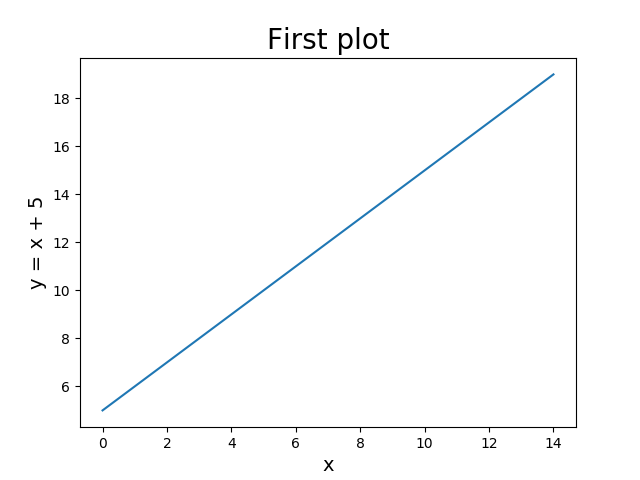
Colors, markers and line styles
- We can chose the style/color of the plots, the style/size of the markers, etc. Here is just a taste:

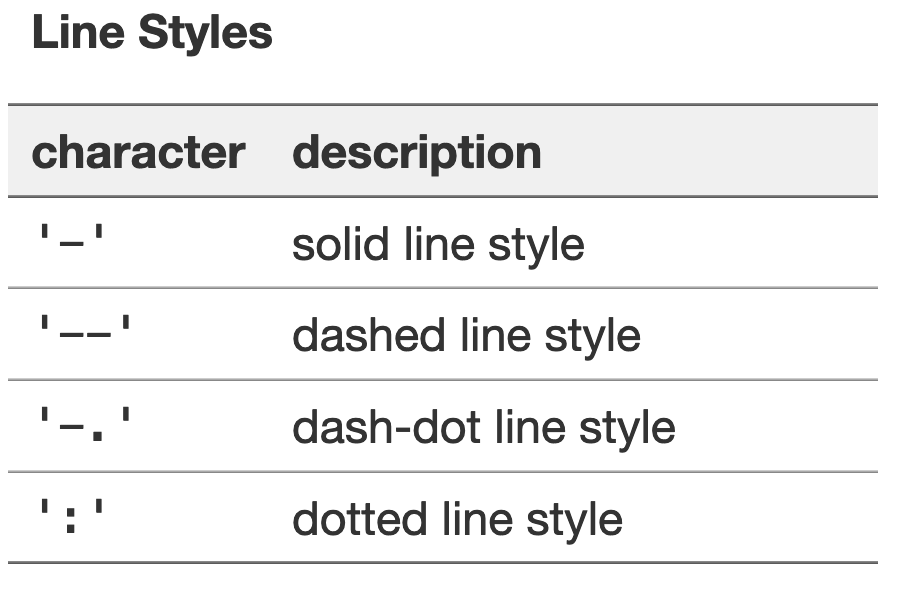

More info: https://matplotlib.org/stable/api/_as_gen/matplotlib.pyplot.plot.html
Using color, marker and line style
- The function plot can take as arguments one or two lists (for x and y coordinates) and a format string.
- The format string consists of three parts: [marker][line][color]. Each part is optional.
1import matplotlib.pyplot as plt23some_numbers = [3, 1, 5, 2, 9, 3]45# circle marker, dashed line, green6plt.plot(some_numbers, "o--g")7plt.show() # display figure
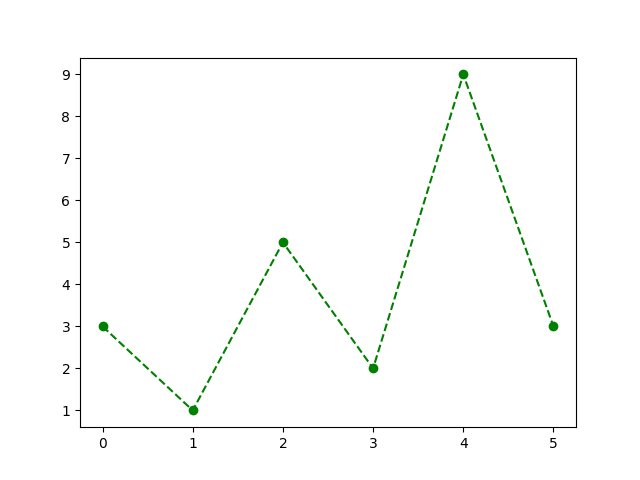
Multiple plots in same figure
1import matplotlib.pyplot as plt2from math import sin, cos, radians34x_coord = range(0, 540, 20)5y_sin = [sin(radians(x)) for x in x_coord]6y_cos = [cos(radians(x)) for x in x_coord]78# + marker, blue color and use label for legend9plt.plot(x_coord, y_sin, '+b', label="sin(x)")1011# magenta color and use label for legend12plt.plot(x_coord, y_cos, 'm', label="cos(x)")13plt.legend() # show legend14plt.show()
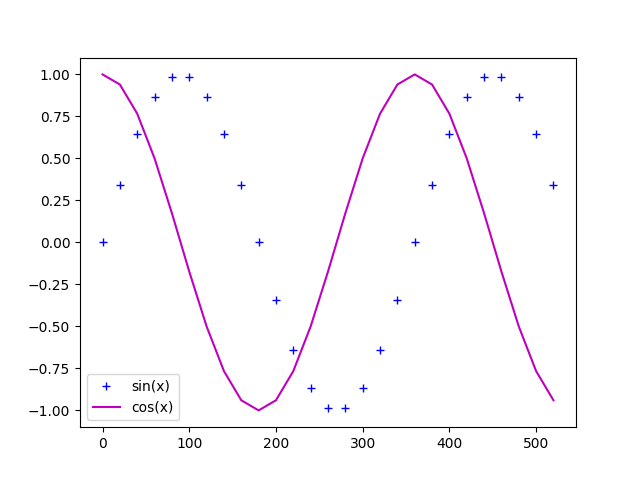
Saving a figure
- plt.savefig(filename): Save the figure in a file (.jpg, .png, etc.)
1import matplotlib.pyplot as plt2from math import sin, radians34x_coord = range(0, 540, 20)5y_sin = [sin(radians(x)) for x in x_coord]67plt.plot(x_coord, y_sin, 'm')89# the figure won't be displayed, but saved in y_sin.png10plt.savefig("myplot.png")
Bar Plots
When working with data that can be broken down into categories, it might be useful for us to use a bar plot instead.
1import matplotlib.pyplot as plt23mtl_pop = [1293992, 1080545, 1015420, 1016376, 1620693, 1704694]4years = ['1966', '1976', '1986', '1996', '2006', '2016']56plt.bar(years, mtl_pop)78plt.title("Population of Montreal")9plt.show()

NumPy and Matplotlib
Matplotlib functions work with NumPy arrays as well.
1import numpy as np2import matplotlib.pyplot as plt34x_values = np.linspace(0, 8, 501)5y_values = np.sin(x_values ** 2) # computes sin(x^2)6plt.plot(x_values, y_values)7plt.show()